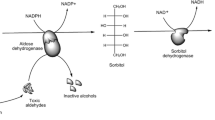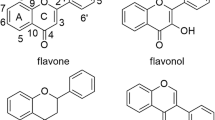Abstract
The primary objective of this study was to investigate the aldose reductase inhibitory activity of flavonoids using in silico docking studies. In this perspective, flavonoids like Apigenin, Baicalin, Daidzein, Epigallocatechin, Galangin, Genistein, Hesperitin, Naringenin, and Scopoletin were selected. Epalrestat, a known aldose reductase inhibitor was used as the standard. In silico docking studies were carried out using AutoDock 4.2, based on the Lamarckian genetic algorithm principle. In the docking studies, three important parameters like binding energy, inhibition constant and intermolecular energy were determined. The results showed that all the selected flavonoids showed binding energy ranging between −9.91 kcal/mol to −7.52 kcal/mol when compared with that of the standard (−8.73 kcal/mol). Intermolecular energy (−11.40 kcal/mol to −8.71 kcal/mol) and inhibition constant (54.78 nM to 3.10 μM) of the flavonoids also coincide with the binding energy. All the selected flavonoids contributed aldose reductase inhibitory activity because of its functional groups. These molecular docking analyses could lead to the further development of potent aldose reductase inhibitors for the treatment of diabetes.



Similar content being viewed by others
References
Calderone V, Chevrier B, Zandt VM, Lamour V, Howard E, Poterszman A, Barth P, Mitchler A, Lu J, Dvornik MD, Klebe G, Kraemer O, Moorman RA, Moras D, Podjarny A (2000) The structure of human aldose reductase bound to the inhibitor IDD384. Acta Crystallogr D 56(5):536–540.
Cosconati S, Forli S, Perryman AL, Harris R, Goodsell DS, Olson AJ (2010) Virtual screening with AutoDock: theory and practice. Expert Opin Drug Discov 5(6):597–607
Cushnie TP, Lamb AJ (2011) Recent advances in understanding the antibacterial properties of flavonoids. Int J Antimicrob Agents 38(2):99–107
Dong Y, Yang J, Ren X, Zhang H, He J (2005) New aldose reductase inhibitors N99-596 A and B from streptomyces. J Antibiot 58:737–739
Gonzalez R, Ballester I et al (2011) Effects of flavonoids and other polyphenols on inflammation. Crit Rev Food Sci Nutr 51(4):331–362
Guzman A, Guerrero OR (2005) Inhibition of aldose reductase by herbs extracts and natural substances and their role in prevention of cataracts. Rev Cubana Plant Med 10:3–4
Hwang YC, Shaw S, Kaneko M et al (2005) Aldose reductase pathway mediates JAK-STAT signaling: a novel axis in myocardial ischemic injury. FASEB J 19:795–797
Lamba HS, Bhargava CS, Thakur M, Bhargava S (2011) α glucosidase and aldose reductase inhibitory activity in vitro and anti diabetic activity in vivo of tribulus terrestris l. (dunal). Int J Pharm Pharmac Sci 3(3):270–272
Li Y, Li C, Xu Q, Kang W (2011) Antioxidant, α-glucosidase inhibitory activities in vitro and alloxan-induced diabetic rats’ protective effect of Indigofera stachyodes Lindl. root. J Med Plants Res 5(14):3321–3328
Liu HB, Wang ZL, Qiao YX, Zhou JJ (2007) Flavonoids with aldose reductase inhibiting activity: pharmacophoremodeling and implications for mechanism. Acta Phys Chim Sin 23:25–35.
Madeswaran A, Umamaheswari M, Asokkumar K, Sivashanmugam T, Subhadradevi V, Jagannath P (2011) In Silico docking studies of lipoxygenase inhibitory activity of commercially available flavonoids J Comput Method Mol Design 1 (4):65–72
Nishiumi S, Miyamoto S et al (2011) Dietary flavonoids as cancer-preventive and therapeutic biofactors. Front Biosci 3:1332–1362
Norgan AP, Coffman PK, Kocher JPA, Katzmann DJ, Sosa CP (2011) Multilevel parallelization of AutoDock 4.2. J Cheminform 3:12–15
Ravindranath TM, Mong PY, Ananthakrishnan R et al. (2009) Novel role for aldose reductase in mediating acute inflammatory responses in the lung. J Immunol 183:8128–8137
Saraswat M, Muthenna P, Suryanarayana P, Petrash JM, Reddy G (2008) Dietary sources of aldose reductase inhibitors: prospects for alleviating diabetic complications. Asia Pac J Clin Nutr 17(4):558–565
Seeliger D, de GrootLigand BL (2010) Docking and binding site analysis with PyMOL and Autodock/Vina. J Comput Aided Mol Des 24(5):417–422
Umamaheswari M, Madeswaran A, Asokkumar K, Sivashanmugam T, Subhadradevi V, Jagannath P (2011) Study of potential xanthine oxidase inhibitors: in silico and in vitro biological activity. Bangladesh J Pharmacol 6:117–123
Umamaheswari M, Madeswaran A, Asokkumar K, Sivashanmugam AT, Subhadradevi V, Jagannath V (2012) Docking studies: search for possible phytoconstituents for the treatment of gout. Int J Biol Pharm Res 3:6–11
Vianna R, Brault A, Martineau LC, Couture R et al (2011) In vivo anti-diabetic activity of the ethanolic crude extract of Sorbus decora C.K.Schneid. (Rosacea): a medicinal plant used by Canadian James Bay Cree Nations to treat symptoms related to diabetes. Evid-Based Complement Alternat Med 1:10–15
Yadav UC, Naura AS, Aguilera AL et al (2009) Aldose reductase inhibition suppresses the expression of Th2 cytokines and airway inflammation in ovalbumin-induced asthma in mice. J Immunol 183:4723–4732
Zhang S, Kumar K, Jiang X (2008) DOVIS: an implementation for high throughput virtual screening using Autodock. BMC Bioinforma 9:126–128
Author information
Authors and Affiliations
Corresponding author
Rights and permissions
About this article
Cite this article
Madeswaran, A., Umamaheswari, M., Asokkumar, K. et al. Discovery of potential aldose reductase inhibitors using in silico docking studies. Orient Pharm Exp Med 12, 157–161 (2012). https://doi.org/10.1007/s13596-012-0065-3
Received:
Accepted:
Published:
Issue Date:
DOI: https://doi.org/10.1007/s13596-012-0065-3




